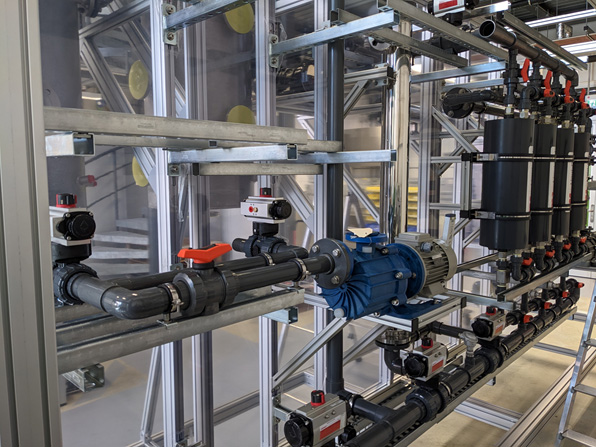Although the raw materials for fertilizer production are becoming increasingly scarce, at the same time large quantities of nutrients are being lost via the sewage system and further energy consumption. The state of the art in most municipal wastewater treatment plants is the removal of nitrogen compounds such as ammonium (NH4+) and nitrate (NO3-) using nitrification and denitrification processes. With high energy consumption, these compounds are converted into gaseous nitrogen that escapes into the air.
Phosphate is removed by chemical precipitation by adding aluminium or iron salts. These phosphate salts are landfilled because they are not available to plants or can release iron and aluminium in concentrations that are toxic to plants. It is estimated that approximately 4.3 million tonnes of phosphorus are lost in this way worldwide each year.
For this reason, the Fraunhofer IGB is developing new technologies for recovering nutrients from wastewater.
Nutrient recovery from wastewater
Recovery of ammonium from wastewater

Nitrogen (N) is one of the nutrients which exists in high concentration in the sludge liquor produced in wastewater treatment plants. Conventional wastewater treatment plants use a high amount of energy to recover nitrogen out of the wastewater – and to release it in its unusable molecular form (N2) into the air.
At Fraunhofer IGB, we research the process of chemical transmembrane absorption as a novel procedure to not only remove ammonium out of waste water, but to recover it for the use as fertilizer instead.
Electrochemical recovery of phophorus
Phosphorus is used in agriculture as a fertilizer. The demand is enormous, since intensive farming reduces soil quality. As natural deposits are diminishing, alternative methods of phosphorus extraction are in demand. One possibility is the recovery from wastewater and residual material streams on the basis of electrochemical processes, which are suitable for use in wastewater treatment plants.
System integration
The Fraunhofer IGB develops processes for the recovery of nutrients from wastewater and waste for customers and partners. In addition, the scientists also support the implementation of the processes in industrial practice, for example by integrating them into existing wastewater treatment plants.
Case studies
The services of the Fraunhofer IGB also include the implementation of case studies, on the basis of which the need for new processes and their feasibility can be communicated in individual cases.
 Fraunhofer Institute for Interfacial Engineering and Biotechnology IGB
Fraunhofer Institute for Interfacial Engineering and Biotechnology IGB